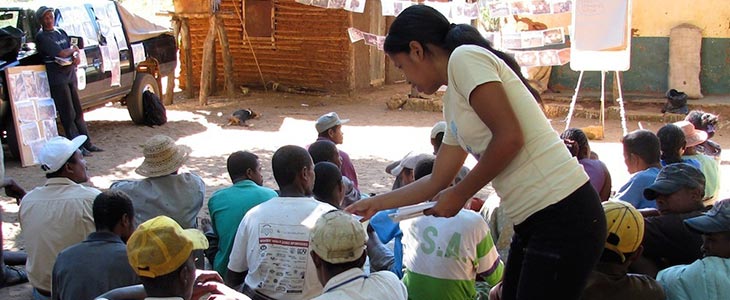
Capacity building is about better equipping individuals and organizations with the abilities and resources to solve problems.
Capacity building supports sustained in situ CWR conservation. Regions rich in biodiversity, including genetic diversity of CWR, also tend to have the lowest levels of skilled specialists. Hence, capacity building must be a major component of the process of planning and implementing CWR in situ conservation.
This module provides guidance to improve individuals’ and organizations’ capacities to carry out activities relating to CWR in situ conservation. It explores options for capacity building within a project-driven context, rather than as part of a national programme or strategy.
Levels of Capacity Development
- Macro level: National institutions and organizations
- Meso Level: Organizations and project teams
- Micro Level: Project staff and individuals
Though this module does not focus on the macro level, this should not imply that the need for such capacity development is not necessary. Individual and institutional capacity goes together. For example, an individuals’ ability to apply his or her knowledge and skills at work depends on an institution’s programmes and leadership, provision of resources and access to outside networks.
Conservation practitioners operate in an environment largely beyond their control and often characterized by competing organizations. We must look beyond individual skills to the ability of organizations to achieve CWR in situ conservation goals.
Sources:
Horton D., Alexaki A., Bennett-Lartey S., et al. (2003) Evaluating capacity development: experiences from research and development organizations around the world. ISNAR, IDRC, ACP-EU, CTA.
Hough, J. (2006) ‘Developing capacity’, in Lockwood, M., Worboys, G. and Kothari, A. (eds) Managing Protected Areas: A Global Guide, Ch 7, pp 164-192, Earthscan, London.
Creating your strategy: A Six-Step Process
1. Reviewing the tasks involved in CWR in situ conservation
Start developing your plan by reviewing the tasks involved and the competencies required to perform them.
2. Capacity building for whom? A stakeholder analysis
Developing community-based capacity is important for enhancing CWR in situ conservation. There are a diverse range of individuals, groups and organizations that will require some level of capacity building in order to make a successful contribution to CWR conservation.
3. What is needed? Establishing the competencies required
- Process-oriented competencies
- Project management competencies
- Technical competencies
4. Assessing capacity building needs and conducting a situation analysis
Assessing the gap between ‘what is’ and ‘what should be’ is known as a capacity building needs assessment. A needs assessment should be done at the start of a programme or project. Needs must be prioritized through consultation and in an open and transparent manner.
5. Developing a capacity building plan or strategy
A capacity development plan will take different shapes depending on the level of intervention (local, project, national, etc.), but it should generally include:
- Aims: the broad purpose of the capacity building actions.
- Learning objectives or outcomes.
- Contents: topics to be covered to bridge the competence gaps identified.
- Implementation plan which includes the selection of tools and methods for capacity building; time allocation; identification of trainers, facilitators, mentors, external resource persons; resources required; logistic considerations.
- Evaluation of training.
6. Monitoring and evaluating the capacity building plan
Methods, criteria and indicators for evaluation need to be formulated early in the process. Decide on what information should be collected and analyzed and who should carry this out. Your evaluation should assess the knowledge, skills and attitudes gained by the learner, the content of the capacity building and the learning processes, in general. Monitoring and evaluation will show if your approach is working , if it needs to be modified, and whether resources are being spent wisely.